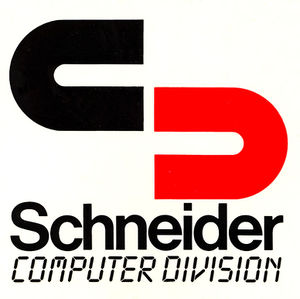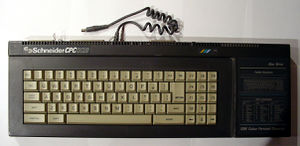| (8 intermediate revisions by 5 users not shown) | |||
| Line 1: | Line 1: | ||
| + | [[Image:Schneider Computer Division logo.jpg|thumb]] | ||
[[image:schneider_6128_en.jpg|thumb|Schneider CPC 6128 with grey Keys and Centronic-Ports]] | [[image:schneider_6128_en.jpg|thumb|Schneider CPC 6128 with grey Keys and Centronic-Ports]] | ||
| + | |||
| + | [[Schneider]] is one the [[LK-selectable Brand Names]] contained in the CPC BIOS. | ||
| + | |||
Schneider Computer Division, a division of the Schneider Rundfunkwerke from Türkheim (Germany) exclusively distributed the [[CPC_old_generation|Amstrad CPC]] 464, 664 and 6128 on the german market under their own brand name Schneider. | Schneider Computer Division, a division of the Schneider Rundfunkwerke from Türkheim (Germany) exclusively distributed the [[CPC_old_generation|Amstrad CPC]] 464, 664 and 6128 on the german market under their own brand name Schneider. | ||
In the middle 80s the Schneider Rundfunkwerke opened the Schneider Computer Division, originally for the sole purpose of distributing the the Amstrad Computers under license. | In the middle 80s the Schneider Rundfunkwerke opened the Schneider Computer Division, originally for the sole purpose of distributing the the Amstrad Computers under license. | ||
| Line 5: | Line 9: | ||
Although the CPC - even the CPCplus - contains soldering points that allow the manufacturer to specify the OEM brand appearing on the boot screen of the computer, the Schneider CPCs had a few more differences from their UK and worldwide siblings: | Although the CPC - even the CPCplus - contains soldering points that allow the manufacturer to specify the OEM brand appearing on the boot screen of the computer, the Schneider CPCs had a few more differences from their UK and worldwide siblings: | ||
* All Schneider CPCs had grey resp. black keys only. The colourful keys of the CPC464 and CPC664 were unknown in Germany. | * All Schneider CPCs had grey resp. black keys only. The colourful keys of the CPC464 and CPC664 were unknown in Germany. | ||
| − | * The German CPC6128 sported proper expansion ports and not mere PCB extensions. These were much more durable and they were implemented because of stricter German laws. Unfortunately this also meant that some [[peripherals]] would have a troubled time trying to connect to the back of the Schneider CPC6128s unless you got an adapter. | + | * The German CPC6128 sported proper expansion ports and not mere PCB extensions (English, Spanish and French CPCs all had edge connectors. The German CPC464 and CPC664 had edge connectors too). These were much more durable and they were implemented because of stricter German laws. Unfortunately this also meant that some [[peripherals]] would have a troubled time trying to connect to the back of the Schneider CPC6128s unless you got an adapter. |
* All manuals by Schneider were spiral bound, while most Amstrad manuals were glued. | * All manuals by Schneider were spiral bound, while most Amstrad manuals were glued. | ||
* The labels of the system disks were translated | * The labels of the system disks were translated | ||
| Line 11: | Line 15: | ||
Amazingly German CPCs didn't have German keyboard layouts though, this feature was reserved for the PCW/Joyce and PC1512/PC1640 models. | Amazingly German CPCs didn't have German keyboard layouts though, this feature was reserved for the PCW/Joyce and PC1512/PC1640 models. | ||
| − | Until 1987 Schneider Computer Division also distributed the Amstrad PCW8256 (also known as Joyce), PCW8125 (Joyce Plus), PC1512 and PC1640. At the end of 1987 Schneider had distanced itself from Amstrad due to differences in dealership policies. | + | Until 1987 Schneider Computer Division also distributed the Amstrad PCW8256 (also known as Joyce), PCW8125 (Joyce Plus), PC1512 and PC1640. At the end of 1987 Schneider had distanced itself from Amstrad due to differences in dealership policies. Amstrad started to distribute the CPC and PCW series via a new german branch named [[Amstrad GmbH]], whilst [[Schneider]] started from 1988 an own production of computers: they built the EuroPC and EuroPCII (two very compact PC units on the same computer-in-a-keyboard format like the CPC6128), EuroXT, EuroAT and TowerAT, which were even 'Made in Germany'. |
Until today you can buy computers with the brand name 'Schneider' on them, though the company has ceased a long time ago and 'Schneider' is just a brand name for Fujitsu-Siemens computers. | Until today you can buy computers with the brand name 'Schneider' on them, though the company has ceased a long time ago and 'Schneider' is just a brand name for Fujitsu-Siemens computers. | ||
| + | |||
| + | == Adverts == | ||
| + | |||
| + | <gallery> | ||
| + | File:Schneider Advert (CPC 7-1986 page 68-69).jpg|Two-page advert from 1986 | ||
| + | </gallery> | ||
| + | |||
| + | [[Category:CPC related companies]] [[Category:German companies]] | ||
Latest revision as of 18:18, 3 December 2016
Schneider is one the LK-selectable Brand Names contained in the CPC BIOS.
Schneider Computer Division, a division of the Schneider Rundfunkwerke from Türkheim (Germany) exclusively distributed the Amstrad CPC 464, 664 and 6128 on the german market under their own brand name Schneider. In the middle 80s the Schneider Rundfunkwerke opened the Schneider Computer Division, originally for the sole purpose of distributing the the Amstrad Computers under license.
Although the CPC - even the CPCplus - contains soldering points that allow the manufacturer to specify the OEM brand appearing on the boot screen of the computer, the Schneider CPCs had a few more differences from their UK and worldwide siblings:
- All Schneider CPCs had grey resp. black keys only. The colourful keys of the CPC464 and CPC664 were unknown in Germany.
- The German CPC6128 sported proper expansion ports and not mere PCB extensions (English, Spanish and French CPCs all had edge connectors. The German CPC464 and CPC664 had edge connectors too). These were much more durable and they were implemented because of stricter German laws. Unfortunately this also meant that some peripherals would have a troubled time trying to connect to the back of the Schneider CPC6128s unless you got an adapter.
- All manuals by Schneider were spiral bound, while most Amstrad manuals were glued.
- The labels of the system disks were translated
Amazingly German CPCs didn't have German keyboard layouts though, this feature was reserved for the PCW/Joyce and PC1512/PC1640 models.
Until 1987 Schneider Computer Division also distributed the Amstrad PCW8256 (also known as Joyce), PCW8125 (Joyce Plus), PC1512 and PC1640. At the end of 1987 Schneider had distanced itself from Amstrad due to differences in dealership policies. Amstrad started to distribute the CPC and PCW series via a new german branch named Amstrad GmbH, whilst Schneider started from 1988 an own production of computers: they built the EuroPC and EuroPCII (two very compact PC units on the same computer-in-a-keyboard format like the CPC6128), EuroXT, EuroAT and TowerAT, which were even 'Made in Germany'. Until today you can buy computers with the brand name 'Schneider' on them, though the company has ceased a long time ago and 'Schneider' is just a brand name for Fujitsu-Siemens computers.


